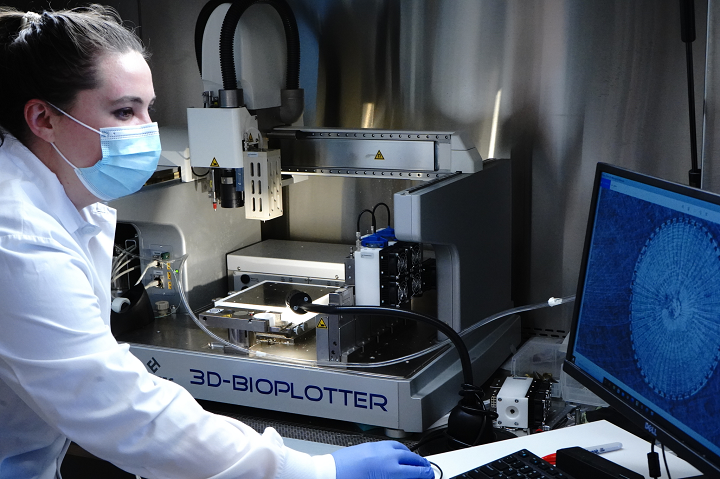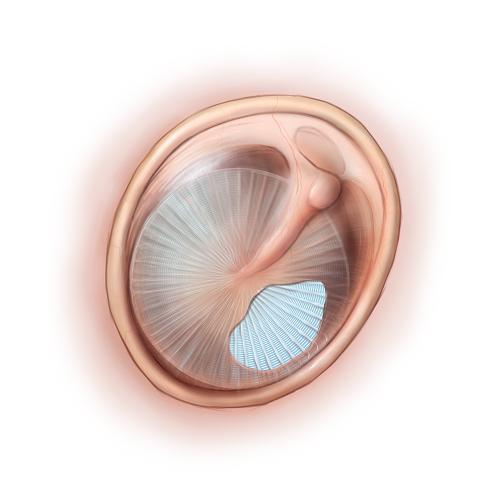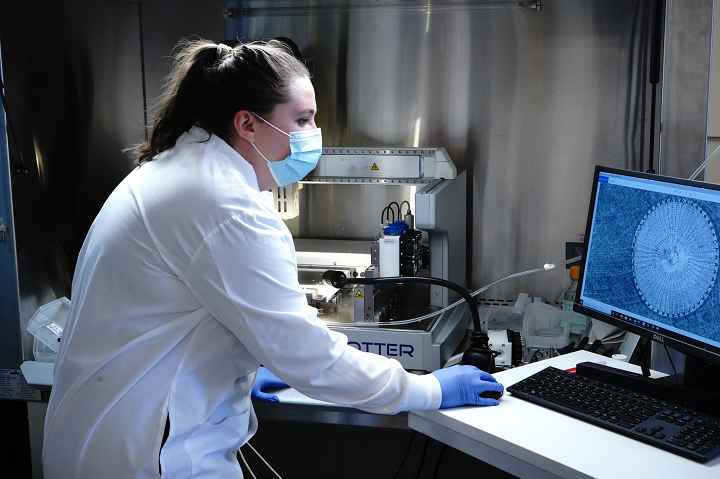On April 15th, 2013, during the annual Boston Marathon, two homemade pressure cooker bombs were planted near the finish line of the race, sadly killing three people and injuring more than two hundred others. Many people sustained eardrum perforations due to the blast injury, which led Nicole Black, PhD, at the time a doctoral student at Harvard University, to think about how 3D printing could be used to achieve better outcomes after eardrum reconstruction.
This was the first step to the creation of the PhonoGraft biofabrication platform, developed by Harvard researchers at the Wyss Institute for Biologically Inspired Engineering, John A. Paulson School of Engineering and Applied Sciences (SEAS), and teaching hospital Mass Eye and Ear. This week, Desktop Health, Desktop Metal‘s (NYSE: DM) medical 3D printing division, announced that it has acquired the platform, and Harvard’s Office of Technology Development granted Desktop Metal an exclusive license to commercialize PhonoGraft, which could potentially support the human body’s functional and morphological regeneration of the tympanic membrane, aka the eardrum, as well as open the door for multiple soft tissue regeneration applications.
“We believe that this platform may one day offer a groundbreaking solution to the millions of patients impacted by tympanic membrane perforation (TMP). PhonoGraft material technology, coupled with our leading biofabrication capabilities, has tremendous potential across a wide range of healthcare applications in soft tissue –from cardiovascular and neuronal grafts to plastic surgery. Today’s announcement marks the beginning of our journey to advance personalized medicine,” stated Michael Jafar, President and CEO of Desktop Health.
At the time that Black, now Desktop Health’s VP of Biomaterials and Innovation, realized the potential opportunity to explore the use of 3D printing in eardrum reconstruction after the bombings, she was a student in the Harvard lab of Jennifer Lewis, ScD, a Core Faculty member at the Wyss Institute. Lewis and her research group followed up quickly on her idea, collaborating with ear surgeons Dr. Aaron Remenschneider and Dr. Elliott Kozin to put together a multidisciplinary team of otolaryngologists and material scientists.
“One of the most prevalent injuries of the Boston Marathon bombing was perforated eardrums. This is also common in military personnel after blast injury and in children and adults with ear infections,” explained Dr. Remenschneider. “Surgical repair of the eardrum is unfortunately necessary for many patients to restore hearing and create a ‘safe’ ear.”

Desktop Metal CEO Ric Fulop (front left) and Desktop Health CEO Michael Jafar (front right) join PhonoGraft team at Greentown Labs in Boston.
The team spent six years in R&D, receiving translational funding from the Wyss Institute, and developed the PhonoGraft material and device, in addition to completing pre-clinical de-risking of the platform. Black and several other colleagues founded the Beacon Bio startup to commercialize PhonoGraft, and Desktop Metal has now acquired that startup.
“I’m delighted for the members of my lab at Harvard and our collaborators at Mass Eye and Ear who jointly developed this innovative technology, and who successfully applied their entrepreneurial drive to demonstrate its potential,” said Lewis, a Hansjorg Wyss Professor of Biologically Inspired Engineering and Jianming Yu Professor of Arts and Sciences at Harvard SEAS. “In addition to TMP relief, this advanced graft technology could pave the way for a multitude of healthcare products in the fields of cardiac, vascular, and plastic surgery.”
So, what exactly is the PhonoGraft device?
The PhonoGraft is a 3D printed, biomimetic graft that could allow for long-lasting, high-quality eardrum reconstruction, as it combines biodegradability with a biomimetic architecture that promotes eardrum regeneration. According to the PhonoGraft website, the programmable graft conducts sound well at both high and low frequencies, which can restore function much better than currently used autologous tissue grafts. Additionally, the team expects that the 3D printed device will improving hearing outcomes and patient healing, which will reduce the need for later revision surgeries.
“This device, which is manufactured from a biodegradable elastomer in the form of customizable biomimetic circular and radial scaffolds, is intended to function like the native eardrum,” explained Black. “Preliminary bench studies show that the PhonoGraft device not only closed the eardrum perforation; it supported the body’s regeneration of the complex eardrum structure. Such graft architectures benefit from the use of 3D printing and permit the eardrum to transmit both low-and high-frequency soundwaves.”
The technology platform, which is in advanced-stage R&D and not currently for sale anywhere, has been validated in animal models during pre-clinical studies, which showed that native blood vessels and cells grow into the biocompatible PhonoGraft material as the eardrum heals. Black and her Desktop Health Team plan to conduct more pre-clinical trials and pursue review and approval from the FDA, which could help usher in opportunities for the technology to be used in additional soft tissue regeneration applications.
Black explained, “This technology has potential to ‘intelligently’ support the regeneration of soft tissues in other areas of the body.”
According to the recent SmarTech Analysis report on “Market Opportunities for 3D printed Prosthetics, Orthotics, and Audiology devices,” revenue from 3D printed orthotics, prosthetics, and audiology devices is expected to reach nearly $1 billion by the year 2030, so it’s no wonder that Desktop Metal and Desktop Health were interested in the PhonoGraft technology. While the report focuses more on behind-the-ear devices, it does also touch on disruptors in the audiology sector, noting that “the potential for new innovations in metal devices and behind-the-ear devices has increased, setting the stage for a new wave of innovation,” and I’d say this biofabrication platform fits the bill in that area.
Subscribe to Our Email Newsletter
Stay up-to-date on all the latest news from the 3D printing industry and receive information and offers from third party vendors.
You May Also Like
Profiling a Construction 3D Printing Pioneer: US Army Corps of Engineers’ Megan Kreiger
The world of construction 3D printing is still so new that the true experts can probably be counted on two hands. Among them is Megan Kreiger, Portfolio Manager of Additive...
US Army Corps of Engineers Taps Lincoln Electric & Eaton for Largest 3D Printed US Civil Works Part
The Soo Locks sit on the US-Canadian border, enabling maritime travel between Lake Superior and Lake Huron, from which ships can reach the rest of the Great Lakes. Crafts carrying...
Construction 3D Printing CEO Reflects on Being Female in Construction
Natalie Wadley, CEO of ChangeMaker3D, could hear the words of her daughter sitting next to her resounding in her head. “Mum, MUM, you’ve won!” Wadley had just won the prestigious...
1Print to Commercialize 3D Printed Coastal Resilience Solutions
1Print, a company that specializes in deploying additive construction (AC) for infrastructure projects, has entered an agreement with the University of Miami (UM) to accelerate commercialization of the SEAHIVE shoreline...


































